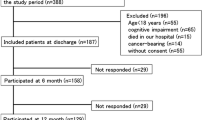Abstract
The aims of this study were to compare outcome after a mild to moderate trauma in three subgroups of patients of increasing age (A1: <50, A2: 50–74, A3: >74 years) and to assess potential health-related quality of life (HRQOL) impairment. This is a follow-up study of a cohort of 418 trauma patients admitted to the High Dependency Unit of the Emergency Department of the University Hospital of Florence from July 2008 to February 2012. Six months after the event, a telephone interview using the Physical component summary (PCS) and Mental component summary (MCS) Health Composite Score (SF12) was conducted. Patients reported their QOL both at present and before trauma. In-hospital mortality was 10 of 418 (2.3 %); overall mortality was 27 of 244 (11 %) patients found at follow-up. No death was observed among A1 patients; overall mortality was (6/76) 7 % in A2 and (21/71) 30 % in A3 patients (p < 0.05 A1 vs A2, A1 vs A3 and A2 vs A3). Before the event, respectively, 94 and 96 % patients reported a normal MCS and PCS score (>39); after the event, the proportion of patients with a normal score value was significantly lower (MCS 70 %, p = 0.002; PCS 58 %, p < 0.0001). All subgroups showed a highly significant reduction in the scores’ value due to the trauma. After the event, the proportion of patients with normal scores was significantly lower (all p < 0.0001, except for MCS score in A1 subgroup, who showed p = 0.013) within all subgroups. Elderly patients’ prognosis was significantly worse compared with the younger counterpart; despite young patients’ optimal outcome, HRQOL was uniformly reduced across all age groups.



Similar content being viewed by others
References
Criddle LM (2006) Outcome in the injured elderly: where do we go from here? J Emerg Nurs 32:234–240
Clark DE, Chu MK (2002) Increasing importance of the elderly in a trauma system. Am J Emerg Med 20:108–111
Grossman MD, Miller D, Scaff DW, Arcona S (2002) When is an elder old? Effect of preexisting conditions on mortality in geriatric trauma. J Trauma 52:242–246
Ferraris VA, Ferraris SP, Saha SP (2010) The relationship between mortality and preexisting cardiac disease in 5,971 trauma patients. J Trauma 69:645–652
Olson CJ, Brand D, Mullins RJ, Harrahill M, Trunkey DD (2003) Time to death of hospitalized injured patients as a measure of quality of care. J Trauma 55:45–52
Fleischman RJ, Adams AL, Hedges JR, Ma OJ, Mullins RJ, Newgard CD (2010) The optimum follow-up period for assessing mortality outcomes in injured older adults. J Am Geriatr Soc 58:1843–1849
Demetriades D, Karaiskakis M, Velmahos G, Alo K, Newton E, Murray J, Asensio J, Belzberg H, Berne T, Shoemaker W (2002) Effect on outcome of early intensive management of geriatric trauma patients. Br J Surg 89:1319–1322
Innocenti F, Bianchi S, Guerrini E, Vicidomini S, Conti A, Zanobetti M, Pini R (2013) Prognostic scores for early stratification of septic patients admitted to an emergency department-high dependency unit. Eur J Emerg Med [Epub ahead of print]
Pandharipande PP, Shintani AK, Hagerman HE, St Jacques PJ, Rice TW, Sanders NW, Ware LB, Bernard GR, Ely EW (2009) Derivation and validation of Spo(2)/FIo(2) ratio to impute for Pao(2)/FIo(2) ratio in the respiratory component of the Sequential Organ Failure Assessment Score. Crit Care Med 37:1317–1321
Apalone G, Mosconi P, Quattrociocchi L, Gianicolo EAL, Groth N, Ware JE Jr (2005) Questionario sullo Stato di Salute Versione Italiana Milano, Istituto di Ricerche Farmacologiche Mario Negri
Gosling CM, Gabbe BJ, Williamson OD, Sutherland AM, Cameron PA (2011) Validity of outcome measures used to assess one and six month outcomes in orthopaedic trauma patients. Injury 42:1443–1448
Ulvik A, Wentzel-Larsen T, Flaatten H (2007) Trauma patients in the intensive care unit: short- and long-term survival and predictors of 30-day mortality. Acta Anaesthesiol Scand 51:171–177
McGwin G Jr, MacLennan PA, Fife JB, Davis GG, Rue LW III (2004) Preexisting conditions and mortality in older trauma patients. J Trauma 56:1291–1296
Antonelli M, Moreno R, Vincent JL, Sprung CL, Mendoca A, Passariello M, Riccioni L, Osborn J (1999) Application of SOFA score to trauma patients. Sequential Organ Failure Assessment. Intensive Care Med 25:389–394
Zygun D, Berthiaume L, Laupland K, Kortbeek J, Doig C (2006) SOFA is superior to MOD score for the determination of non-neurologic organ dysfunction in patients with severe traumatic brain injury: a cohort study. Crit Care 10:R115. doi:10.1186/cc5007
Richmond TS, Kauder D, Strumpf N, Meredith T (2002) Characteristics and outcomes of serious traumatic injury in older adults. J Am Geriatr Soc 50:215–222
Conti M, Merlani P, Ricou B (2012) Prognosis and quality of life of elderly patients after intensive care. Swiss Med Wkly 142:w13671
Kaarlola A, Tallgren M, Pettila V (2006) Long-term survival, quality of life, and quality-adjusted life-years among critically ill elderly patients. Crit Care Med 34:2120–2126
de Rooij SE, Govers AC, Korevaar JC, Giesbers AW, Levi M, de Jong E (2008) Cognitive, functional, and quality-of-life outcomes of patients aged 80 and older who survived at least 1 year after planned or unplanned surgery or medical intensive care treatment. J Am Geriatr Soc 56:816–822
Tabah A, Philippart F, Timsit JF, Willems V, Francais A, Leplege A, Carlet J, Bruel C, Misset B, Garrouste-Org (2010) Quality of life in patients aged 80 or over after ICU discharge. Crit Care 14:R2
Inaba K, Goecke M, Sharkey P, Brenneman F (2003) Long-term outcomes after injury in the elderly. J Trauma 54:486–491
Badia X, Diaz-Prieto A, Gorriz MT, Herdman M, Torrado H, Farrero E, Cavanilles JM (2001) Using the EuroQol-5D to measure changes in quality of life 12 months after discharge from an intensive care unit. Intensive Care Med 27:1901–1907
Conflict of interest
None.
Author information
Authors and Affiliations
Corresponding author
Rights and permissions
About this article
Cite this article
Innocenti, F., Coppa, A., Del Taglia, B. et al. Prognosis and health-related quality of life in elderly patients after a mild to moderate trauma. Intern Emerg Med 9, 467–474 (2014). https://doi.org/10.1007/s11739-013-1039-2
Received:
Accepted:
Published:
Issue Date:
DOI: https://doi.org/10.1007/s11739-013-1039-2




